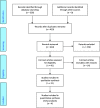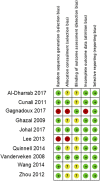Factors influencing adherence to oral appliance therapy in adults with obstructive sleep apnea: a systematic review and meta-analysis
- PMID: 33660611
- PMCID: PMC8314619
- DOI: 10.5664/jcsm.9184
Factors influencing adherence to oral appliance therapy in adults with obstructive sleep apnea: a systematic review and meta-analysis
Abstract
Study objectives: The review aimed to identify the factors influencing adherence to oral appliance therapy in adults with obstructive sleep apnea.
Methods: The protocol was initially registered with the International Register of Systematic Reviews (Prospero: CRD42019122615) prior to undertaking a comprehensive electronic search of databases and references without language and date restrictions. Quality assessment was undertaken using the Cochrane Collaboration's risk of bias tool and Quality in Prognosis Studies (QUIPS) tool.
Results: Studies exhibited low or unclear risk of bias for the domains assessed by the respective quality assessment tools. The influence of independent variables such as disease characteristics, patient characteristics, appliance features, and psychological and social factors on adherence levels was also assessed. There was a total of 31 included studies, which consisted of 8 randomized controlled trials, 2 controlled clinical trial, 7 prospective cohorts, 11 retrospective cohorts, and the remaining 3 studies were a case-series, case-control, and a mixed-methods. All 31 included studies were subject to qualitative analysis, with only 4 studies included in the quantitative analysis. Results of the meta-analysis demonstrated increased adherence with custom-made appliances, with a pooled mean difference of -1.34 (-2.02 to -0.66) and low levels of heterogeneity (I² = 0%).
Conclusions: A weak relationship was observed between objective adherence and patient and disease characteristics, such as age, sex, obesity, apnea-hypopnea index, and daytime sleepiness, to oral appliance therapy. Nonadherent patients reported more side effects with oral appliance therapy than users and tended to discontinue the treatment within the first 3 months. Custom-made oral appliances were preferred and increased adherence reported in comparison to ready-made appliances. Further research is imperative to examine the relationship between psychosocial factors and adherence to oral appliance therapy.
Keywords: dental sleep medicine; obstructive sleep apnea; oral appliance therapy; patient adherence.
© 2021 American Academy of Sleep Medicine.
Conflict of interest statement
All authors have seen and approved the manuscript. Work for this study was performed at the Department of Oral Bioengineering, Institute of Dentistry, Queen Mary University of London, London, UK. The systematic review is part of a PhD program that is university-sponsored. The authors Prof. Ama Johal and Prof. Padhraig S. Fleming are salaried employees of the Centre for Oral Bioengineering, Queen Mary University of London, and Prof Tim Newton of the Department of Population and Patient Health, King’s College London. The authors report no conflicts of interest.
Figures



Similar articles
-
Oral appliance therapy for the management of obstructive sleep apnea in adults: an umbrella review.JBI Evid Synth. 2025 May 1;23(5):876-919. doi: 10.11124/JBIES-23-00539. Epub 2025 Mar 31. JBI Evid Synth. 2025. PMID: 40159944
-
Comparative evaluation of the efficacy of customized maxillary oral appliance with mandibular advancement appliance as a treatment modality for moderate obstructive sleep apnea patients-protocol for a randomized controlled trial.Trials. 2022 Feb 16;23(1):159. doi: 10.1186/s13063-022-06070-w. Trials. 2022. PMID: 35172870 Free PMC article.
-
Oral appliance versus continuous positive airway pressure in obstructive sleep apnea syndrome: a 2-year follow-up.Sleep. 2013 Sep 1;36(9):1289-96. doi: 10.5665/sleep.2948. Sleep. 2013. PMID: 23997361 Free PMC article. Clinical Trial.
-
Comparative evaluation of the efficacy of customized maxillary oral appliance with mandibular advancement appliance as a treatment modality for moderate obstructive sleep apnea patients-a randomized controlled trial.Trials. 2023 Feb 1;24(1):73. doi: 10.1186/s13063-022-07054-6. Trials. 2023. PMID: 36726182 Free PMC article. Clinical Trial.
-
[Orofacial myofunctional reeducation assisted by a prefabricated reeducation appliance: a systematic review of the literature].Orthod Fr. 2023 Apr 28;94(1):131-161. doi: 10.1684/orthodfr.2023.126. Orthod Fr. 2023. PMID: 37114821 French.
Cited by
-
The role of oral appliance therapy in obstructive sleep apnoea.Eur Respir Rev. 2023 Jun 21;32(168):220257. doi: 10.1183/16000617.0257-2022. Print 2023 Jun 30. Eur Respir Rev. 2023. PMID: 37343962 Free PMC article. Review.
-
ERS International Congress 2023: highlights from the Allied Respiratory Professionals Assembly.ERJ Open Res. 2024 Mar 25;10(2):00889-2023. doi: 10.1183/23120541.00889-2023. eCollection 2024 Mar. ERJ Open Res. 2024. PMID: 38529350 Free PMC article.
-
A Multicenter Prospective Study on the Use of a Mandibular Advancement Device in the Treatment of Obstructive Sleep Apnea.Dent J (Basel). 2023 Oct 24;11(11):247. doi: 10.3390/dj11110247. Dent J (Basel). 2023. PMID: 37999010 Free PMC article.
-
Patient-Centered Therapy for Obstructive Sleep Apnea: A Review.Medicina (Kaunas). 2022 Sep 23;58(10):1338. doi: 10.3390/medicina58101338. Medicina (Kaunas). 2022. PMID: 36295499 Free PMC article. Review.
-
Effect of mandibular advancement appliance use on oral and periodontal health in patients with OSA: a systematic review.Sleep Breath. 2024 May;28(2):1005-1017. doi: 10.1007/s11325-023-02971-5. Epub 2023 Dec 21. Sleep Breath. 2024. PMID: 38123720
References
-
- SIGN . Management of Obstructive Sleep Apnoea/Hypopnoea Syndrome in Adults: A National Clinical Guideline. Edinburgh, UK: Scottish Intercollegiate Guidelines Network; 2003.
-
- Rejon-Parrilla JC, Garau M, Sussex J. Obstructive Sleep Apnoea: Health Economics Report. London: Office of Health Economics; 2014.
Publication types
MeSH terms
LinkOut - more resources
Full Text Sources
Other Literature Sources

